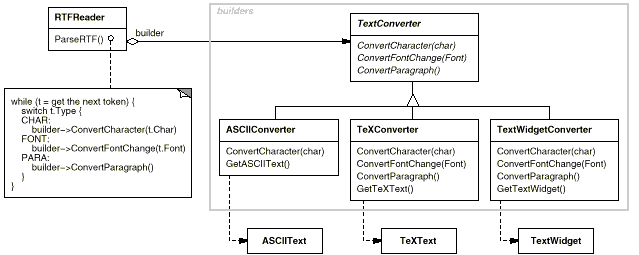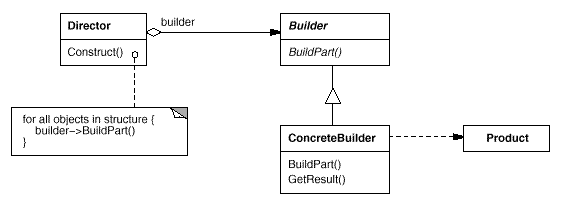Builder (Pattern)
The Builder pattern of this page is based on the book Design Patterns: Elements of Reusable Object-Oriented Software [1].
Intent
Separates the construction of a complex object from its representation so that the same construction process can create different representations.
Motivation
A reader for the RTF (Rich Text Format) document exchange format should be able to convert RTF to many text formats. The reader might convert RTF documents into plain ASCII text or into a text widget that can be edited interactively. The problem, however, is that the number of possible conversions is open-ended. So it should be easy to add a new conversion without modifying the reader.
A solution is to configure the RTFReader class with a TextConverter object that converts RTF to another textual representation. As the RTFReader parses the RTF document, it uses the TextConverter to perform the conversion. Whenever the RTFReader recognizes an RTF token (either plain text or an RTF control word), it issues a request to the TextConverter to convert the token. TextConverter objects are responsible both for performing the data conversion and for representing the token in a particular format.
Subclasses of TextConverter specialize in different conversions and formats. For example,
- An ASCIIConverter ignores requests to convert anything except plain text.
- A TeXConverter, on the other hand, will implement operations for all requests in order to produce a TeX representation that captures all the stylistic information in the text.
- A TextWidgetConverter will produce a complex user interface object that lets the user see and edit the text.
Each kind of converter class takes the mechanism for creating and assembling a complex object and puts it behind an abstract interface. The converter is separate from the reader, which is responsible for parsing an RTF document.
The Builder pattern captures all these relationships. Each converter class is called a builder in the pattern, and the reader is called the director. Applied to this example, the Builder pattern separates the algorithm for interpreting a textual format (that is, the parser for RTF documents) from how a converted format gets created and represented. This lets us reuse the RTFReader's parsing algorithm to create different text representations from RTF documents—just configure the RTFReader with different subclasses of TextConverter.
Applicability
Use the Builder pattern when
- The algorithm for creating a complex object should be independent of the parts that make up the object and how they're assembled.
- The construction process must allow different representations for the object that's constructed.
Participants
Builder (TextConverter)
- specifies an abstract interface for creating parts of a Product object.
ConcreteBuilder (ASCIIConverter, TeXConverter, TextWidgetConverter)
- constructs and assembles parts of the product by implementing the Builder interface.
- defines and keeps track of the representation it creates.
- provides an interface for retrieving the product (e.g., GetASCIIText, GetTextWidget).
Director (RTFReader)
- constructs an object using the Builder interface.
- Product (ASCIIText, TeXText, TextWidget)
- represents the complex object under construction. ConcreteBuilder builds the product's internal representation and defines the process by which it's assembled.
- includes classes that define the constituent parts, including interfaces for assembling the parts into the final result.
Collaborations
- The client creates the Director object and configures it with the desired Builder object.
- Director notifies the builder whenever a part of the product should be built.
- Builder handles requests from the director and adds parts to the product.
- The client retrieves the product from the builder.
Consequences
The key consequences of the Builder pattern:
- It lets you vary a product's internal representation. The Builder object provides the director with an abstract interface for constructing the product. The interface lets the builder hide the representation and internal structure of the product. It also hides how the product gets assembled. Because the product is constructed through an abstract interface, all you have to do to change the product's internal representation is define a new kind of builder.
- It isolates code for construction and representation. The Builder pattern improves modularity by encapsulating the way a complex object is constructed and represented. Clients needn't know anything about the classes that define the product's internal structure; such classes don't appear in Builder's interface.
Each ConcreteBuilder contains all the code to create and assemble a particular kind of product. The code is written once; then different Directors can reuse it to build Product variants from the same set of parts. In the earlier RTF example, we could define a reader for a format other than RTF, say, an SGMLReader, and use the same TextConverters to generate ASCIIText, TeXText, and TextWidget renditions of SGML documents. - It gives you finer control over the construction process. Unlike creational patterns that construct products in one shot, the Builder pattern constructs the product step by step under the director's control. Only when the product is finished does the director retrieve it from the builder. Hence the Builder interface reflects the process of constructing the product more than other creational patterns. This gives you finer control over the construction process and consequently the internal structure of the resulting product.
Related Patterns
- Abstract Factory is similar to Builder in that it too may construct complex objects. The primary difference is that the Builder pattern focuses on constructing a complex object step by step. Abstract Factory's emphasis is on families of product objects (either simple or complex). Builder returns the product as a final step, but as far as the Abstract Factory pattern is concerned, the product gets returned immediately.
- A Composite is what the builder often builds.
Complete Language examples
- GitHub hjmf1954, Java Builder Pattern example. A complete working demo in Java and ANT.
See also
Reference
- ↑ Design Patterns: Elements of Reusable Object-Oriented Software, The Gang of Four (GoF), Authors Erich Gamma, Richard Helm, Ralph Johnson and John Vlissides with a foreword by Grady Booch, 1994, ISBN 0-201-63361-2. There are PDF files of the book on the internet

